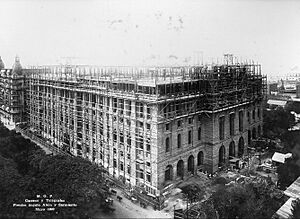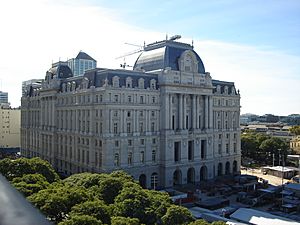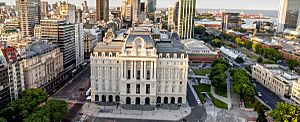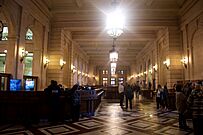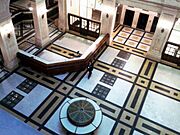Libertad Palace facts for kids
Quick facts for kids Libertad Palace, Domingo Faustino Sarmiento Cultural Center |
|
|---|---|
|
Palacio Libertad, Centro Cultural Domingo Faustino Sarmiento
|
|
 |
|

The building in 2019
|
|
| General information | |
| Status | Complete |
| Type | Government |
| Location | Sarmiento 151 Buenos Aires |
| Coordinates | 34°36′12″S 58°22′10″W / 34.60333°S 58.36944°W |
| Construction started | 1908 |
| Completed | 1928 |
| Opening | 1928 |
| Height | |
| Roof | 60 m (200 ft) |
| Technical details | |
| Floor count | 8 |
| Floor area | 88,050 m2 (947,800 sq ft) |
| Design and construction | |
| Architect | Norbert Maillart |
| Developer | Government of Argentina |
| Main contractor | GEOPÉ |
The Libertad Palace, Domingo Faustino Sarmiento Cultural Center (which means "Liberty Palace, Domingo Faustino Sarmiento Cultural Center" in Spanish) is a huge place for arts and culture in Buenos Aires, Argentina. It's the biggest cultural center in Latin America and one of the largest in the world!
This amazing building first opened in 1928. Back then, it was the main post office for Buenos Aires, called the "Palacio de Correos." It worked as a post office until 2002. After that, it was renovated and reopened in 2015 as a cultural center. For a few years, it was named after a former president, Néstor Kirchner, who helped turn it into a cultural hub. However, the name was changed in March 2024. As of October 10, 2024, the building is officially called "Palacio Libertad, Centro Cultural Domingo Faustino Sarmiento."
The center has nine floors filled with exciting spaces. There's a big concert hall and five other auditoriums for plays and music. You can find 18 halls for poetry readings and other events. There are also 40 rooms with art and history exhibits, covering a huge area on six floors. Plus, it has 16 rehearsal rooms and two rooftop terraces with great views. You can easily get there using the city's underground trains, on Line B or Line E.
Contents
History of the Building
From Post Office to Cultural Hub
The idea for a new main post office in Buenos Aires came up in 1888. The head of the Argentine Postal Service, Dr. Ramón J. Cárcano, first suggested it. Soon after, a law was passed to build it. A French architect named Norbert Maillart was hired to design it in 1889.
The government chose a large city block for the building. It was located near the Río de la Plata river, on land that had recently been reclaimed from the water. This spot was picked to make the area look nicer. However, a big financial crisis in 1890 caused the project to stop.
The government started the plans again in 1905. In 1908, Maillart returned to Buenos Aires with new, bigger plans, which were approved. But later, Maillart and the Argentine government had disagreements, and he left the project in 1911. Construction had just begun, so Maillart's main assistant, Jacques Spolsky, took over. Spolsky changed the design to use strong steel-reinforced concrete instead of just stone. They placed almost 3,000 steel pillars deep into the ground.
World War I caused more delays and budget problems. A planned elevated road was canceled, so a new lower entrance was added. Spolsky managed this without changing the outside of the building much. But all the delays made the project very expensive. The money ran out in 1923. However, President Marcelo Torcuato de Alvear got more funds from Congress. Finally, on September 28, 1928, the new post office was officially opened.
The building's design mixes many styles, especially French Second Empire architecture. This was common for public buildings in Buenos Aires during the early 1900s. Even with their disagreements, Maillart went on to design other important buildings. Spolsky also designed similar post offices in other Argentine cities.
This building was the largest public building in Argentina at the time. It had eight stories and was 60 meters (200 feet) tall. Inside, it had over 88,000 square meters (948,000 square feet) of space. The main hall was decorated with marble, beautiful stained glass windows, and bronze sculptures. It also had a tall, domed ceiling.
Changes Over the Years
Because the building was so grand, President Juan Perón moved his offices there in the 1940s. His wife, Eva Perón, even set up the first offices for her charity, the Eva Perón Foundation, in one part of the building.
Later, the plaza in front of the post office became a parking lot. In the 1970s, there were plans to sell the parking lot to build a bank. But many people were against it, so the plans were stopped. Instead, an underground parking garage was built, and the area above became a park in 1983.
In 1997, the building was named a National Historic Monument. Most of its postal work had moved to a newer building years before. By 2005, the last post office section closed.
Becoming a Cultural Center
In 2005, President Néstor Kirchner suggested turning the old post office into a cultural center. Two years later, plans were approved to build two concert halls and an exhibition gallery. The winning design was created by architects Enrique, Federico, and Nicolás Bares.
The center was supposed to open on May 25, 2010, for Argentina's 200th anniversary. But it took longer than expected. When it finally opened in May 2015, it was named the Centro Cultural Kirchner (Kirchner Cultural Centre).
When the architects added new parts, they used modern materials like clear glass and stainless steel. This was done on purpose so that people could still see the beautiful old design of the original building. The main concert hall, called La Sala Sinfonica (which used to be called La Ballena Azul, or "The Blue Whale"), can hold 1,950 people. It looks like a giant blimp and floats in what used to be the package-sorting area. It has a huge pipe organ with about eight thousand pipes! Other important areas include the Sala Federal for music, and La Cúpula and Sala Argentina for live theater.
After President Mauricio Macri took office, the center became part of a new government group for media and public content. They wanted to change the focus away from Néstor Kirchner. The center started to be called "Palacio Libertad." The room that used to honor Kirchner was removed. There were plans to rename the center the "Bicentennial Cultural Centre." In 2016, a bill was even introduced to stop naming public places after presidents who had not been gone for at least 20 years.
The Argentine National Symphony Orchestra, which started in 1948 but didn't have a permanent home for 67 years, now performs regularly at the center.
Many people visit the Liberty Centre every day, sometimes as many as 10,000! All events are currently free. The Culture Ministry believes that art should be available to everyone. In 2017, the center hosted an important international meeting when Argentina's president took over the G20 presidency.
In March 2024, the government announced that the center's name would change again. Two months later, they said it would be called "Palacio Libertad." They chose this name because it was not linked to any specific political ideas. On October 10, 2024, the government officially changed the name to "Palacio Libertad, Centro Cultural Domingo Faustino Sarmiento."
Gallery
See also
 In Spanish: Centro Cultural Domingo Faustino Sarmiento para niños
In Spanish: Centro Cultural Domingo Faustino Sarmiento para niños
- Buildings and structures in Buenos Aires
- National Historic Monuments of Argentina
- Teatro Colón


